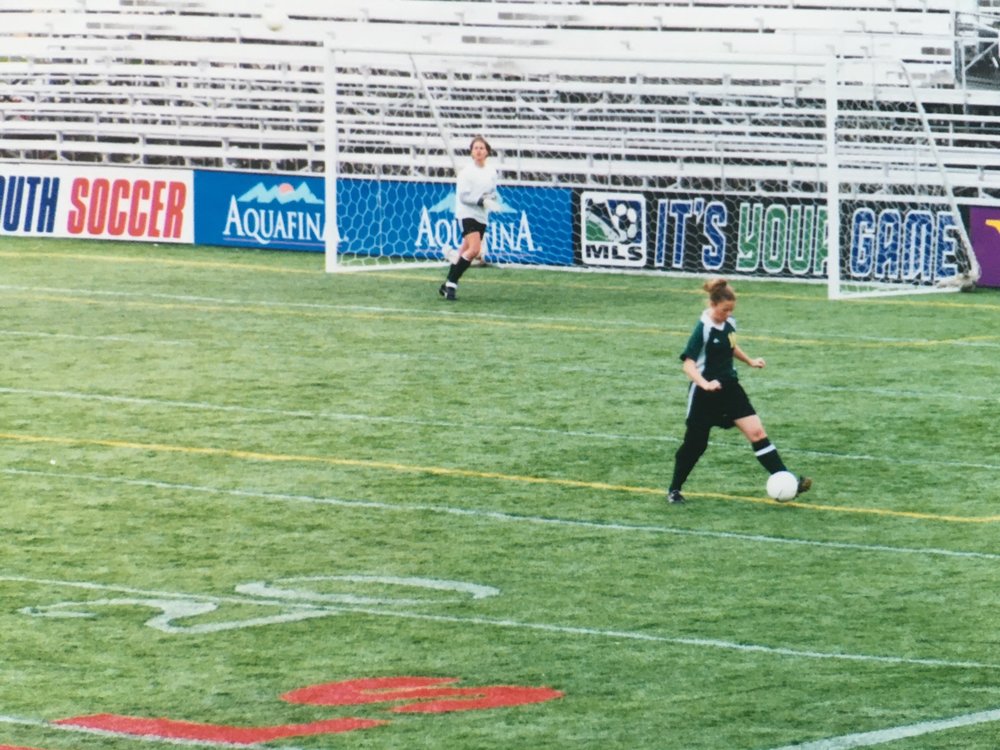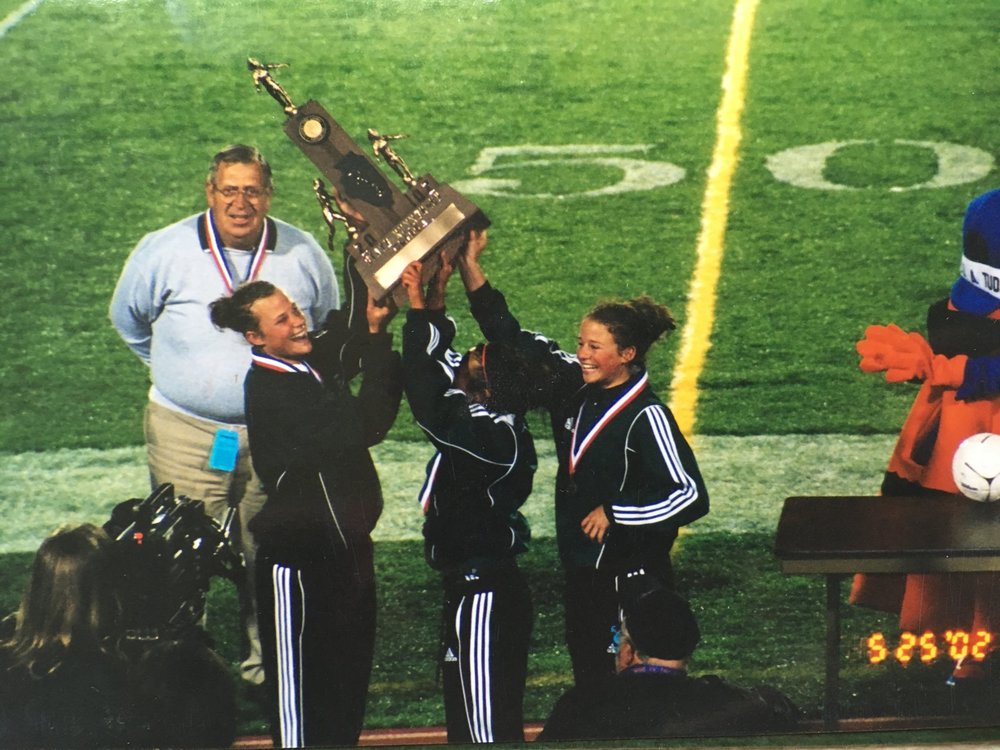If there’s one thing to know about knee injury in youth soccer, it’s that tearing the ACL (anterior cruciate ligament) is common and is often devastating for a young, driven athlete. The risks for this type of injury are many fold, but young female athletes are at a higher risk for injury and reinjury than their male counter parts. Point in case: yours truly here. In 2001, I tore my right ACL playing soccer. Let me tell you the story:
It was a dark and stormy night in the dead of winter (true story actually, it was November and really dark with snow and wind). As a team, we were returning to an indoor game after about 4 weeks off from regular club season. I was 16 years old at the time and let me tell you, I was NOT motivated to stay fit independently while we were on break. While I WAS motivated to be working on my skills, juggling, etc; it was winter, in Illinois and there is only so much a gal can do in that situation (excuses). I was out of shape. Plain and simple. Went into the game and within the first 10 minutes, cut and pivoted to try and defend a ball, and collapsed to the ground. I felt a snap in my knee, pain, and complete fear wash over my body. No words can describe that moment other than ones that I was using at the time, which are not suitable for this post. Strangely enough, about 10 minutes later, after being carried off the field, I was up and walking and felt so weird about the entire event. How on earth could I be walking after such pain? I naively assumed it was a knee sprain. I had absolutely no idea what an ACL was, and frankly didn’t care. I was walking and figured I’d be back in no time. The next day, my mom insisted on taking me to the doctor. We went, he did his exam, and the news was grave. I had torn my ACL and the recovery for this injury was 6 months minimum. With tears streaming down my face, I realized I would miss my entire high school season, and after having made the regional team, would miss my opportunity to progress at the level I had dreamed. Devastating is an understatement. Not only was I not prepared for a moment like this, I was completely unequipped to accept my fate was written for me. Which was such a blessing. The mental and physical aspects of my recovery were complex but it was my grit and “Sisu-like” determination that pushed me to succeed. I returned to play at 4 months, having passed all of their required return to sport tests. This included hop tests, agility tests, strength tests, vertical tests, all of it. This would not have been possible, without frequent expression of my own goals to my recovery team and hard work.

That’s me with the ball, looking pretty fierce in what was frequently referred to as my “Attila the Hun” brace
For many young athletes recovering from ACL reconstruction, this timeframe for return to play is a pipe dream, as median time for return to sport is 9 months (1). Not only do many surgeons not recommend return to play prior to 6 months, most of the research is bent out of shape about when to return to play and what is an appropriate measure to determine readiness. The consensus around this topic is improving, but there is still some controversy. In the history of this injury, time from surgery has been the number one guideline for return to play. Frankly, the literature does not support this recommendation as there are so many other factors to consider, including but not limited to: age, sex, functional performance, strength, graft type, psychological readiness, fear, and many more variables (2). In fact, much of the literature shows that many athletes continue to have functional and strength deficits at 2 years post-operatively (2). If I am any example, I can tell you, I’m now 15 years post-op and definitely continue to have deficits, however those deficits have not stopped me. I have gone 15 years without secondary injury (knock on wood), played at the division I collegiate level, and continue to play competitively as an adult.
So, why do we tell athletes they can’t return to sport until 6 months post-op you ask? In my professional opinion, risk for re-injury is the simple answer. Some research has shown that if you are younger than 25 years of age, your risk for secondary injury increases 30-40 times (3). My job as your physical therapist is to balance the inherent risks with so many other things so that you return to sport safely and with confidence. The more skilled your physical therapist is at this, the more likely you are to succeed.
If you want some light reading, The 2016 Consensus Statement on Return to Sport from the First World Congress in Sports Physical Therapy beautifully summed up strategic and individualized return to sport guidelines/recommendations.
“Return to sport is not a decision taken in isolation at the end of the recovery and rehabilitation process. Instead, return to sport should be viewed as a continuum, paralleled with recovery and rehabilitation. Biopsychosocial models may help the clinician make sense of individual factors that may influence the athlete’s return to sport, and the strategic assessment of risk and risk tolerance framework may help decision-makers synthesise information to make an optimal return to sport decision.” (4)
“Strategic assessment of risk and risk tolerance.” That’s a huge part of your recovery whether you know it or not. In particular, that part should be taken with an individualized approach, as everyone moves differently, thinks differently, and plays differently. I would argue, that if you, as a patient, are motivated, understand risks, demonstrate solid performance on functional testing, strength testing, ligamentous testing, psychological readiness testing, movement assessments, endurance testing, agility testing and more (phew!), that you might be ready for return to play at 4 months but only after a thorough discussion with your physical therapist, parents, the surgeon, and even your coach. Do those variables have anything to do with the time from surgery? You bet they do. However, should time from surgery be your primary target for return to play after ACL reconstruction? Absolutely not.
The benefits of gradually progressing back to sport, and finding a therapist who can help you do that safely, often outweigh the risks for many, as it did for me. Only your post operative care team will know and understand what that looks like for you as an individual. That makes it even more valuable for you to communicate your goals with them. Having a physical therapist and post operative care team that is willing to work with you, as an individual, to understand your unique goals, and for all of you to be working as a team in the recovery process, is absolutely KEY.
Remember, return to sport after ACL reconstruction is not a linear process. Your providers, or your child’s providers, should understand that. Take it from a person who experienced, first hand, the benefits of an individualized approach. I went on to be a part of a runner-up state championship team that year, where I played many minutes in the championship game only 5 months post operatively. A memory that fills me with so many empowering and positive emotions. Were it not for my team of providers after surgery, who listened to me, pushed me towards the right physical goals, and steered the ship in a direction that would help me achieve my goals, I’m not sure I would have seen that beautiful moment in my life come to fruition. They listened to me, they heard me, and they pushed me towards the goals I so desperately wanted to achieve. So take it from me, communicate to your providers and tell them your goals. In the end, it’s not about them, it’s about YOU.
Cheers,
Dr. Ellie Somers, Physical Therapist
References:
-
Chicorelli AM, Micheli LJ, Kelly M, Zurakowski D, MacDougall R. Return to sports after anterior cruciate ligament reconstruction in the skeletally immature athlete. Clin J Sport Med 2016;26:266-271.
-
Czuppon S, Racette BA, Klein SE, Harris-Hayes M. Variables associated with return to sport following anterior cruciate ligament reconstruction: a systematic review. Br J Sports Med 2014;48:365-364.
-
Wiggins AJ, Grandhi RK, Schneider DK, et al. Risk of secondary injury in younger athletes after anterior cruciate ligament reconstruction: a systematic review and meta-analysis. Am J Sports Med 2016;1-16.
-
Ardern C, Glasgow P, Schneiders A et al. 2016 Consensus statement on return to sport from the first world congress in sports physical therapy, Bern. Br J Sports Med 2016;50:853-864.

Me on the right side, holding the 2nd Place Trophy for the Illinois State Championship in 2001 just 5 months after my surgery
Returning to sport after injury and not sure where to start? Schedule an appointment today!






